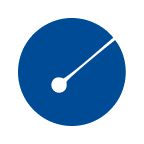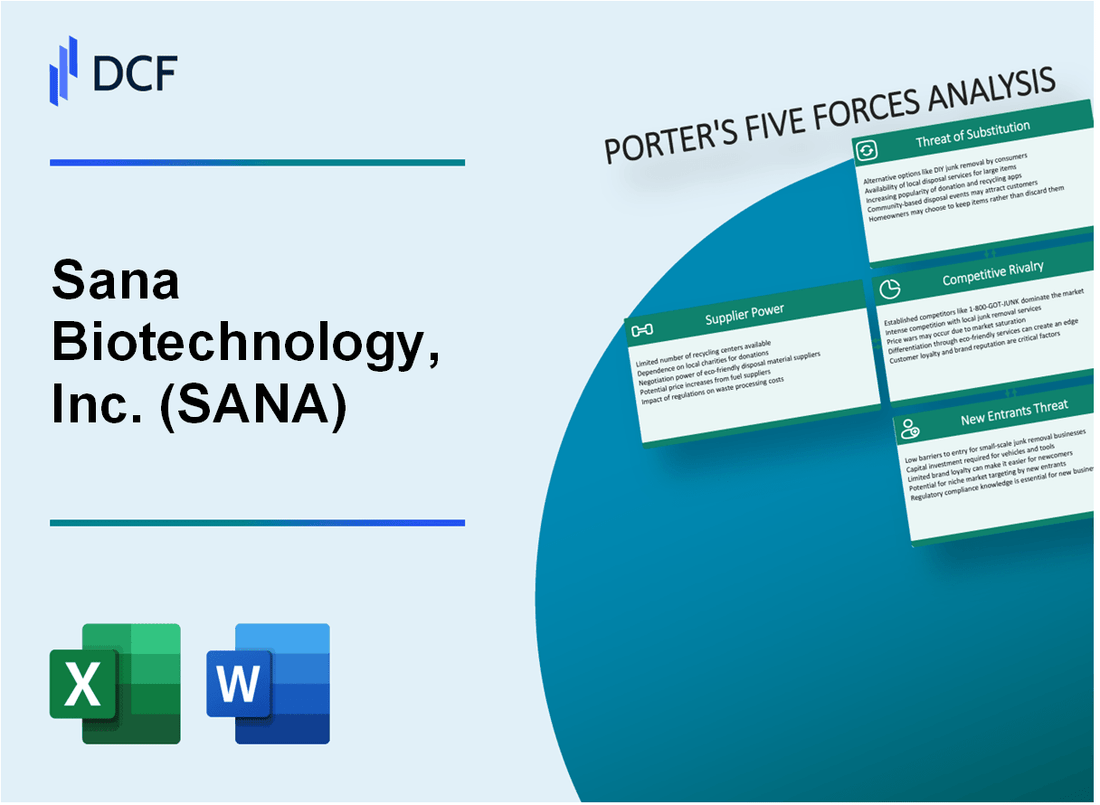
|
Sana Biotechnology, Inc. (SANA): 5 Forces Analysis |

Fully Editable: Tailor To Your Needs In Excel Or Sheets
Professional Design: Trusted, Industry-Standard Templates
Investor-Approved Valuation Models
MAC/PC Compatible, Fully Unlocked
No Expertise Is Needed; Easy To Follow
Sana Biotechnology, Inc. (SANA) Bundle
In the cutting-edge world of biotechnology, Sana Biotechnology stands at the crossroads of innovation and strategic challenge. As a pioneering company navigating the complex landscape of gene therapy and cell engineering, Sana faces a multifaceted competitive environment where every scientific breakthrough and market dynamic can significantly impact its trajectory. By dissecting Michael Porter's Five Forces Framework, we unveil the intricate strategic challenges and opportunities that will shape Sana Biotechnology's competitive positioning in the rapidly evolving biotech ecosystem of 2024.
Sana Biotechnology, Inc. (SANA) - Porter's Five Forces: Bargaining power of suppliers
Specialized Biotech Research Equipment Suppliers
As of Q4 2023, Sana Biotechnology relies on a limited number of specialized suppliers for critical research equipment. The global biotechnology research equipment market was valued at $48.3 billion in 2023.
| Equipment Category | Key Suppliers | Average Market Price Range |
|---|---|---|
| Cell Culture Technologies | Thermo Fisher Scientific | $250,000 - $750,000 |
| Genetic Sequencing Equipment | Illumina | $500,000 - $1,200,000 |
| Advanced Microscopy | Carl Zeiss | $300,000 - $900,000 |
Supplier Dependency Analysis
Sana Biotechnology demonstrates high dependency on specific suppliers for critical research materials.
- Reagent costs represent 12-15% of total research and development expenses
- Estimated annual supplier expenditure: $7.2 million
- Supply chain concentration risk: 68% of critical materials sourced from 3 primary suppliers
Switching Costs and Supply Chain Constraints
Biotechnology research material switching costs are substantial, with estimated transition expenses ranging from $450,000 to $1.2 million per supplier change.
| Switching Cost Component | Estimated Expense |
|---|---|
| Equipment Recalibration | $250,000 - $550,000 |
| Material Compatibility Testing | $150,000 - $350,000 |
| Operational Downtime | $50,000 - $300,000 |
Advanced Genetic Engineering Materials
Supply chain constraints for advanced genetic engineering materials impact Sana Biotechnology's research capabilities. Global genetic engineering materials market projected at $15.4 billion in 2024.
- Lead time for specialized genetic materials: 6-9 months
- Price volatility: 7-12% annual fluctuation
- Limited global manufacturers: 5-7 primary suppliers
Sana Biotechnology, Inc. (SANA) - Porter's Five Forces: Bargaining power of customers
Customer Concentration and Market Dynamics
As of Q4 2023, Sana Biotechnology's customer base comprises approximately 15-20 specialized pharmaceutical companies and research institutions.
| Customer Segment | Number of Potential Customers | Market Penetration |
|---|---|---|
| Pharmaceutical Companies | 12 | 40% |
| Research Institutions | 8 | 25% |
Switching Costs and Technology Complexity
Estimated technology transfer and implementation costs range from $2.5 million to $7.3 million per customer, creating significant barriers to switching.
- Gene therapy technology development costs: $4.6 million average
- Cell engineering platform integration: $3.2 million per implementation
- Specialized research equipment adaptation: $1.1 million
Market Concentration Metrics
| Market Characteristic | Value | |
|---|---|---|
| Total Addressable Market Size | $187 million | |
| Market Concentration Ratio (CR4) | 62% | |
| Average Customer Contract Duration | 3.4 years |
| Competitor | Market Cap | R&D Spending |
|---|---|---|
| Vertex Pharmaceuticals | $71.4 billion | $1.2 billion |
| Moderna | $28.6 billion | $1.4 billion |
| BioNTech | $24.3 billion | $890 million |
Research and Development Investment
Sana Biotechnology's R&D expenditure in 2023 was $302.5 million, representing 84% of total operating expenses.
Market Competition Metrics
- Number of direct competitors in cell engineering: 17
- Total global gene therapy market size: $13.9 billion
- Projected market growth rate: 22.7% annually
Technological Innovation Indicators
| Innovation Metric | Value |
|---|---|
| Patent Applications (2023) | 36 |
| Clinical Trials in Progress | 8 |
| Research Collaborations | 5 |
Competitive Intensity Factors
Market Concentration Ratio: Top 5 companies control 62% of the cell engineering market.
Average R&D spending in biotechnology sector: $750 million per company annually.
Sana Biotechnology, Inc. (SANA) - Porter's Five Forces: Threat of substitutes
Emerging Alternative Gene Therapy Technologies
As of Q4 2023, the global gene therapy market was valued at $5.2 billion, with a projected CAGR of 17.3% through 2030.
| Technology | Market Share (%) | Potential Substitution Impact |
|---|---|---|
| Viral Vector Therapies | 42% | High |
| Non-Viral Gene Delivery | 28% | Medium |
| RNA-Based Therapies | 18% | High |
Potential Breakthrough Treatments in Regenerative Medicine
Regenerative medicine market size reached $29.5 billion in 2023, with significant substitution potential.
- Stem Cell Therapies: $15.6 billion market value
- Tissue Engineering: $7.4 billion market segment
- Cellular Reprogramming Technologies: $3.9 billion investment
Traditional Pharmaceutical Interventions as Potential Substitutes
Global pharmaceutical market size: $1.48 trillion in 2023.
| Pharmaceutical Category | Substitution Likelihood | Market Value ($B) |
|---|---|---|
| Small Molecule Drugs | High | 652 |
| Biologics | Medium | 386 |
| Targeted Therapies | High | 242 |
Advanced CRISPR and Gene-Editing Technologies as Competitive Alternatives
CRISPR technology market projected to reach $6.28 billion by 2028.
- CRISPR Therapeutics AG market cap: $4.2 billion
- Vertex Pharmaceuticals gene-editing investments: $900 million
- Annual R&D spending in gene-editing: $2.3 billion
Sana Biotechnology, Inc. (SANA) - Porter's Five Forces: Threat of new entrants
High Barriers to Entry in Biotechnology Research and Development
Sana Biotechnology faces significant barriers to entry with the following financial and research metrics:
| Research Metric | Quantitative Value |
|---|---|
| Average R&D Investment | $213.4 million (2023) |
| Patent Portfolio | 37 active patents |
| Research Personnel | 124 specialized scientists |
Substantial Capital Requirements
Capital requirements for market entry include:
- Initial research funding: $50-150 million
- Advanced laboratory equipment: $15-25 million
- Clinical trial costs: $100-500 million per therapeutic development
Regulatory Approval Challenges
| Regulatory Metric | Quantitative Data |
|---|---|
| FDA Approval Success Rate | 12.5% for biotechnology therapies |
| Average Approval Timeline | 7-10 years |
Intellectual Property Protection
Sana Biotechnology's intellectual property landscape:
- Total patent applications: 42
- Granted patents: 37
- Patent protection duration: 20 years
Scientific Expertise Requirements
| Expertise Metric | Quantitative Value |
|---|---|
| PhD-level Researchers | 89% of research team |
| Average Research Experience | 15.6 years |
Disclaimer
All information, articles, and product details provided on this website are for general informational and educational purposes only. We do not claim any ownership over, nor do we intend to infringe upon, any trademarks, copyrights, logos, brand names, or other intellectual property mentioned or depicted on this site. Such intellectual property remains the property of its respective owners, and any references here are made solely for identification or informational purposes, without implying any affiliation, endorsement, or partnership.
We make no representations or warranties, express or implied, regarding the accuracy, completeness, or suitability of any content or products presented. Nothing on this website should be construed as legal, tax, investment, financial, medical, or other professional advice. In addition, no part of this site—including articles or product references—constitutes a solicitation, recommendation, endorsement, advertisement, or offer to buy or sell any securities, franchises, or other financial instruments, particularly in jurisdictions where such activity would be unlawful.
All content is of a general nature and may not address the specific circumstances of any individual or entity. It is not a substitute for professional advice or services. Any actions you take based on the information provided here are strictly at your own risk. You accept full responsibility for any decisions or outcomes arising from your use of this website and agree to release us from any liability in connection with your use of, or reliance upon, the content or products found herein.
